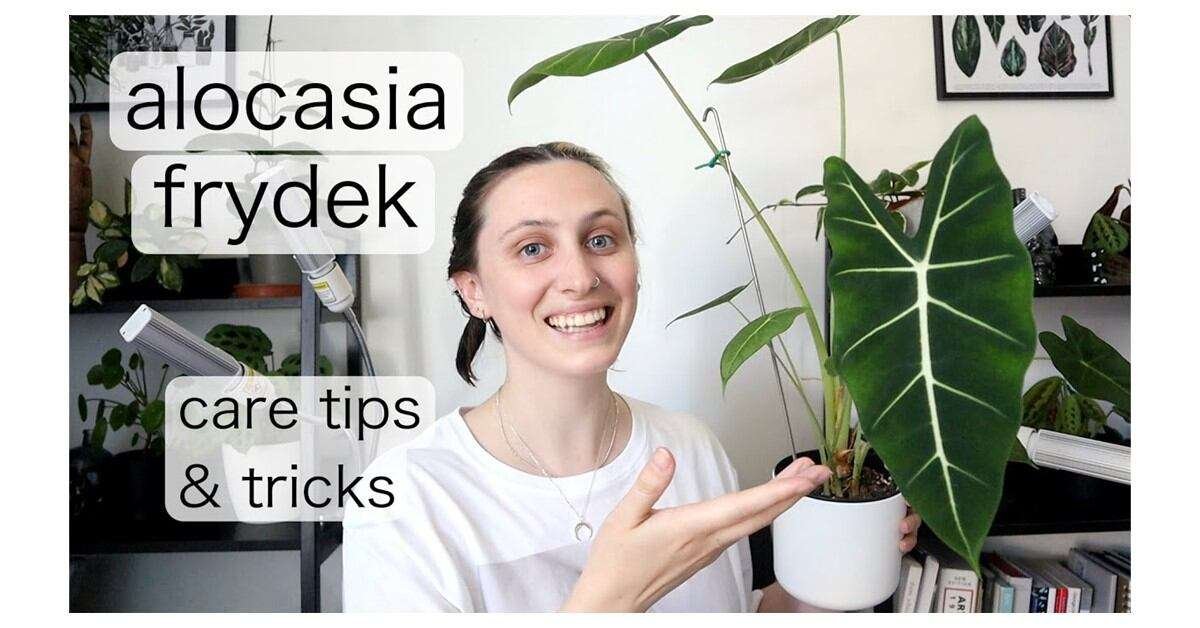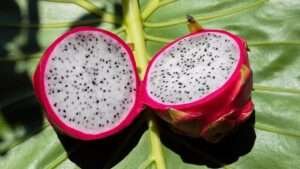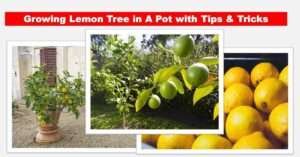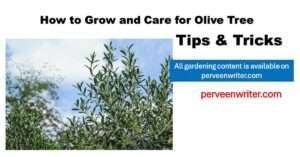What you will read in this Blog?
ToggleIntroduction to Alocasia Frydek
Alocasia frydek is a beautiful cultivar with striking white veining on velvety dark green foliage. It can be grown outside in some areas, but due to its increasing popularity, it is usually cultivated indoors as a houseplant. Like most Alocasias, the frydek can be difficult to maintain, but the effort is well worth it because of its gorgeous foliage. Beware, pet owners: Alocasia frydek, along with all other plants in its genus, is poisonous to horses, dogs, and cats.
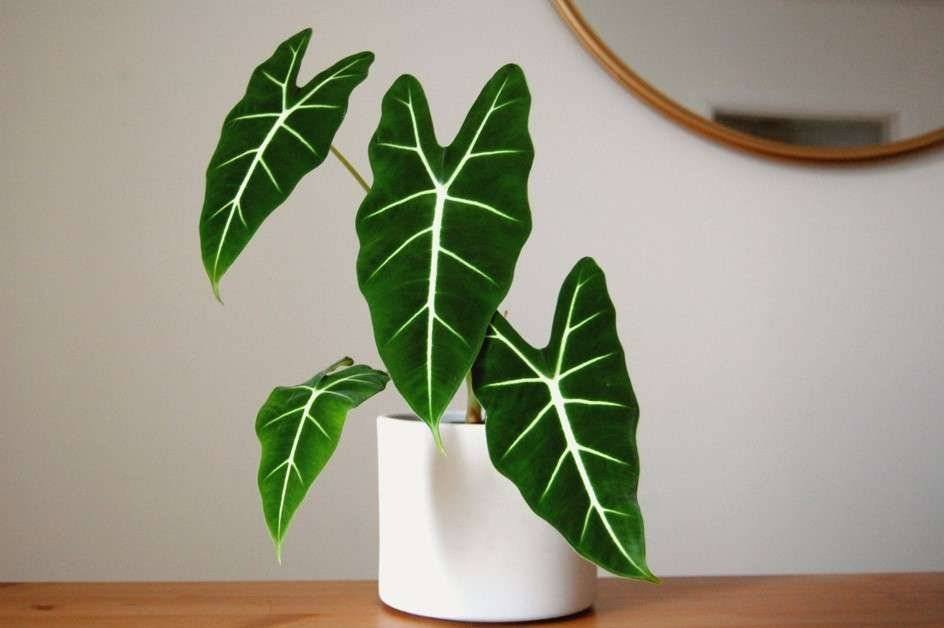
Care for Alocasia Frydek
Like many other Alocasia species, keeping the frydek content indoors might be difficult. That being said, the frydek can flourish under the correct circumstances. One of the most crucial parts of its care is making sure this plant has enough moisture. These tropical aroids will not survive in dry conditions or extended droughts; instead, they prefer frequent irrigation and high humidity.
You may observe a green spadix developing from the heart of your happy and healthy Alocasia frydek. Although it’s not frequent, mature plants can flower when grown indoors.
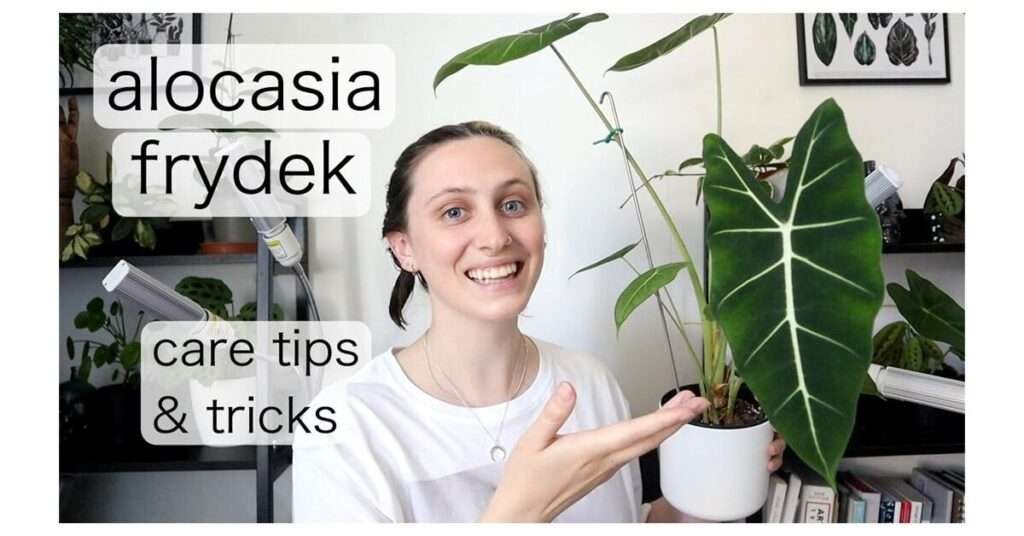
Light
When cultivated inside, this alocasia thrives in bright, indirect light; it prefers partial shade when grown outdoors. Its velvety leaves will be burned if left in the sun for extended periods. The ideal location is in front of a window that faces north or east.
Soil
Alocasia frydek is an aroid in an airy, rich, moist, and well-draining potting mix. Avoid using indoor potting soil with no extra additives, as this can eventually clump and choke the plant’s roots. The best combination is one part potting soil, one part perlite, one part orchid bark, and one part worm castings or compost.
Water
The soil needs to remain uniformly damp without ever becoming soggy. Water the plant when there is 1 to 2 inches of dried soil, letting any extra water drop out the bottom. This plant will require different amounts of water at other times of the year, so make sure you are watering according to the dryness of the soil rather than following a strict schedule that could lead to over- or under-watering.
Humidity and Temperature
The lush, humid tropical rainforests of the Philippines are the natural habitat of Alocasia frydek. Due to its particular humidity and temperature needs, the plant is typically grown inside as a houseplant outside the Philippines. 65 to 85 Fahrenheit temperature is best for its growth. Nevertheless, USDA zones 9 through 11 have winter-hardy plant varieties, allowing for year-round outdoor growth. Normal home humidity levels are adequate, but more humidity will make it flourish. Consider putting a tiny humidifier nearby or pick a naturally humid space like the kitchen, laundry area, or restroom.
Apply fertilizer
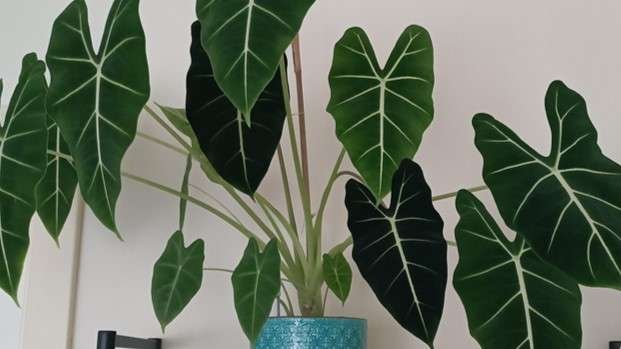
If it grows actively in summer, Alocasia frydek should be fertilized monthly. Apply a balanced liquid fertilizer with routine irrigation. Stop fertilizing this plant during the fall and winter.
Growing New Alocasia Frydek Seeds
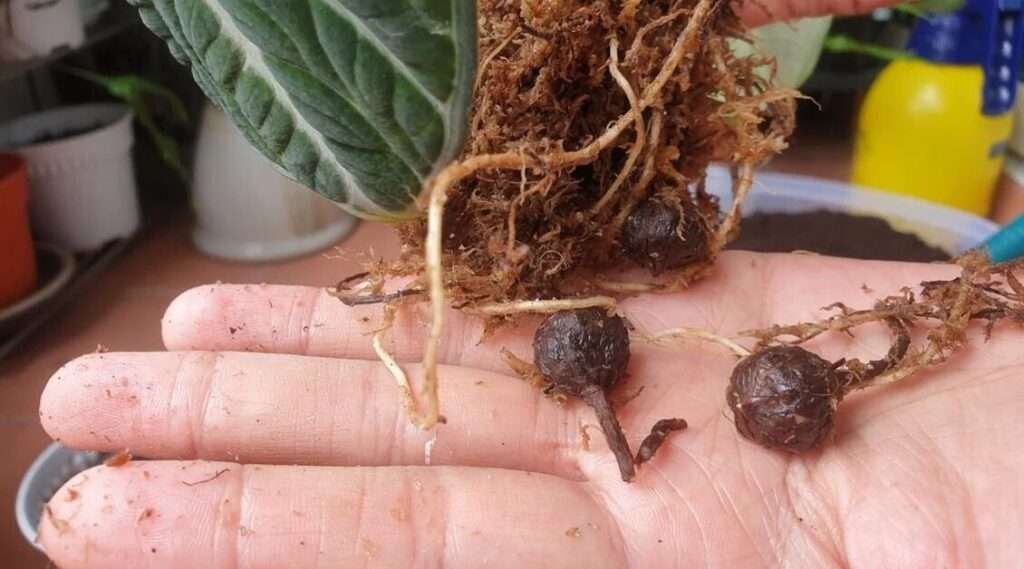
The simplest method of multiplying the Alocasia frydek, as with all Alocasias, is via division during repotting. But if you find any little corms while repotting, you can also grow new Alocasias by doing this, albeit it will take longer and be less reliable. Never attempt to propagate an alocasia by taking a stem cutting; it will not work. Cuttings cannot propagate Alocasias. Using both propagation strategies in the spring or early summer is best.
If you want to divide an Alocasia frydek, ensure the plant has at least two bulbs where leaves are actively growing. Take these actions.
- Take the plant out of its pot and carefully brush out as much dirt as possible from the roots.
- Using a sharp knife, cut between at least one of the huge bulbs to separate it from the remainder of the plant.
- After splitting the bulb, please place it in a pot and moisten the soil.
Please make sure the corms you use to develop corms for an Alocasia frydek are either attached to the plant’s main root system or have their own set of tiny roots. Free-lying corms in the ground without any root system are probably dead and won’t produce anything. Adhere to the following guidelines to spread these corms.
- If the corms are attached, carefully cut them off from the main root system; if they have some roots of their own, remove them from the soil.
- The corms should be placed in a shallow dish of water with the top of the corm above the water and the bottom submerged. Shallow bowls or tiny bottle caps can be useful for this.
- A glass container covers the dish or bottle top to produce a moist, greenhouse-like atmosphere.
- After placing the corms in an area with medium to brilliant indirect light, give them some time to mature. It can take several months to observe any growth at all. The corm is still alive and can grow as long as it isn’t mushy.
- You can attempt moving the corm into the soil after its roots are at least 2 to 3 inches long. Plant the infant Alocasia in airy, well-drained soil.
- Reposition it in bright, indirect light, ensuring the soil is consistently moist. Recovering the glass container over the little plant could aid in its further establishment.
Alocasia Frydek: Potting and Repotting
The Alocasia frydek requires only one pottery every two to three years and thrives on being somewhat root-bound. When the plant is no longer dormant, repotting is best done in the spring or early summer. To avoid hurting the plant’s roots, put as much of the old potting mix as possible in a new pot that is just one or two sizes larger.
Overwintering
Alocasias cultivated indoors frequently lose all of their leaves and hibernate over the winter. Thus, when the outside temperature drops and your plant appears to have died, don’t panic. The plant will reappear in the spring if the bulb is still solid and living. It should be noted that the plant does not require much watering or fertilization during this dormant phase. Only water it when the soil’s upper half has dried out. As a new leaf emerges, you can start watering more frequently again in the spring.
Common Plant Diseases & Pests
Many common pests, such as fungus gnats, spider mites, mealybugs, scale, and thrips, can affect Alocasia frydek plants. To detect any possible infestations early, routinely check your plant for pest indications. If pests are discovered, treat the plant immediately with neem oil or an indoor insecticidal soap, keeping it apart from the rest of your houseplants to stop them from spreading.
Common Issues With Alocasia Frydek
Growers may encounter frequent issues when learning to take care of an Alocasia frydek. Pay attention to the following.
Withering Leaves
Due to their sensitivity to abrupt environmental changes, alocasias may display drooping leaves when their growing conditions alter. Variations in temperature, light, humidity, and watering can all lead to the outer leaves drooping and occasionally dying off. Once your plant has acclimated to its new surroundings, it should begin to thrive again as long as it still receives the bare minimum of light, water, humidity, and warmth.
Losing the Leave
An abrupt change in the growing environment of Alocasia frydek might occasionally cause it to start shedding part or all of its leaves. Alocasia is typical during the fall and winter when the days get shorter and the temperature decreases. The plant leaves will fall as they enter dormancy and only sprout new leaves in the early spring. Even though this may shock you, your frydek will grow back as long as the plant bulb is solid and active.
Grass Yellow Leaves
While there are several potential causes of yellow leaves, overwatering or underwatering is typically the culprit. To ensure the soil around your Alocasia frydek stays consistently moist, keep holes in the pot and put them in the soil to absorb excessive water.
FAQs for Alocasia Frydek
1. Is Alocasia Hard to Care For?
Reading the thorough care instructions for Alocasia Frydek makes it clear that, although it needs certain circumstances to flourish, this plant is not extremely difficult to care for—especially for someone who has previously worked with houseplants.
Green Velvet Alocasias require high humidity, bright, indirect light, and certain watering schedules, which can be difficult to maintain. Still, they can be kept healthy and beautiful with the correct arrangement and regular care. The secret to success is keeping a careful eye on its surroundings and modifying care procedures to make the closest feasible imitation of its natural home.
2. Is Alocasia Frydek Rare?
Because of its distinct look and particular maintenance requirements, the Alocasia Frydek is a somewhat uncommon variety within the Alocasia genus. Its striking visual appeal—velvety green leaves with brilliant white veins—also contributes to its rarity, making it a sought-after plant among enthusiasts and collectors.
However, growers are now propagating it more frequently due to its popularity, gradually increasing its accessibility in the houseplant market. The Alocasia Frydek is still a sought-after species due to its beauty and the difficulty it poses for those who want to care for it, even with its growing availability properly.
3. Does Alocasia Grow Fast?
Growing quickly is not a characteristic of Alocasia Frydek. In ideal circumstances, its growth rate can be deemed modest. A tropical plant requires bright, indirect light, warmth, high humidity, and regular watering.
Even with perfect conditions, the Alocasia Frydek is a slow-growing plant that prefers to concentrate on maintaining its eye-catching leaves on quick growth. You can see more noticeable growth if you give it the right care throughout its active growth season, which runs from spring through summer. However, growth will dramatically slow as the plant enters a dormant phase in the fall and winter.
4. Can Alocasia Survive Without Water?
With some trade-offs, alocasia plants, such as the Alocasia Frydek, have a special adaptation that enables them to live in environments with less sunshine than they would ideally desire. They tolerate low light levels even if they prefer strong, indirect sunlight.
It’s crucial to remember that inadequate light can cause a plant to develop more slowly and may even cause it to become lanky as it reaches for the light. Lower light levels may also lessen the remarkable contrast between its velvety green leaves and white veins. Consider adding a grow lamp as a supplement to guarantee your Alocasia frydek keeps growing even in the absence of direct sunshine, especially in the gloomier winter months.
5. Does Alocasia Multiply?
Alocasia Frydek and other plants in the genus Alocasia may multiply, mostly by dividing their tubers or rhizomes. When using this form of propagation, the tiny plants, called “pups,” are usually carefully separated from the parent plant after they have grown their root systems. Repotting, which is best done in the spring or early summer to correspond with the plant’s active growth period, is usually when this happens.
It’s crucial to remember that this procedure requires caution and patience to protect the fragile root system. By splitting up their Alocasia Frydek plants, gardeners may effectively increase the size of their collection or give them to other plant lovers, extending the beauty and joy these eye-catching plants bring into homes.
What is the best soil for Frydek?
An aerated, well-draining soil mixture that mimics the natural tropical habitat of Alocasia frydek is ideal. The best mixture is peat, perlite, and orchid bark since it keeps moisture without getting soggy and gives the roots air and water. The high humidity required for Alocasia frydek roots is supported by this composition, which also guards against problems like root rot that might arise from excessive moisture.
Adding a small amount of activated charcoal can also help maintain the soil’s freshness and lower the likelihood of fungal illnesses. A healthy and developing plant depends on regular checks to ensure the soil stays slightly moist, especially throughout the growing season.
What is the Best Fertilizer for Alocasia Frydek?
Regular fertilization is essential for Alocasia frydek to grow as best it can, especially from spring through summer when it is actively growing. A balanced, water-soluble fertilizer with an equal proportion of nitrogen, phosphorous, and potassium (N-P-K), like a 20-20-20 formulation, is the ideal fertilizer for Alocasia frydek.
This should be applied at half strength to reduce the chance of chemical burns, which could harm the fragile root system and leaves. Fertilization should be done every four to six weeks while the plant grows. Fertilization should be decreased or stopped throughout the fall and winter dormant seasons to avoid overfeeding, which can cause unhealthy or even dead plants.
6. Can You Grow Alocasia from Seed?
While it is possible to grow Alocasia frydek from seeds, it is more difficult and time-consuming than dividing the plant. Alocasia seeds should be planted in a moist soil mixture that drains well and be maintained warm—ideally, between 75 and 85°F (24 and 29°C). It’s important to keep the area surrounding the seeds humid; you can do this by covering the pot with a plastic sheet. Even after a few weeks of germination, seedlings must be handled carefully since they are fragile.
